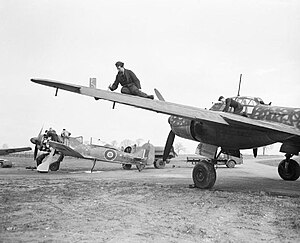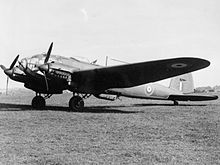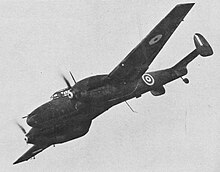No. 1426 Flight RAF
| No. 1426 Flight RAF | |
|---|---|
 A Focke-Wulf Fw 190 and a Junkers Ju 88 of 1426 Flight undergoing maintenance by RAF ground crew at RAF Collyweston (February 1945) | |
| Active | 21 Nov 1941 – 17 Jan 1945 1 Jan 1956 – 31 Dec 1956[1] |
| Role | Enemy aircraft evaluation and demonstration |
| Garrison/HQ | RAF Duxford RAF Collyweston RAF Khormaksar |
| Equipment | Messerschmitt Bf 109E-3/F-4/G-2/G-6/G-14 Messerschmitt Bf 110C-5 Focke-Wulf Fw 190A-4 Heinkel He 111H-3 Junkers Ju 88A-5/A-6/G-1/R-1/S-1 Henschel Hs 129B-1 Avro Anson I Airspeed Oxford II General Aircraft Monospar ST-25 Avro Lincoln B.1[1] |
No. 1426 (Enemy Aircraft) Flight RAF, nicknamed "the Rafwaffe", was a Royal Air Force flight formed during the Second World War to evaluate captured enemy aircraft and demonstrate their characteristics to other Allied units. Several aircraft on charge with the RAE Farnborough section were also used by this unit. The RAE facilities at Farnborough were utilised for the flight testing of German and Italian aircraft during the war.
Many crash-landed airframes were brought to Farnborough for examination, testing and cannibalisation of spare parts to keep other aircraft in serviceable condition. The main flight testing work was carried out by the Aerodynamics Flight of the Experimental Flying Department and the Wireless & Electrical Flight (W&EF), the latter responsible for evaluation and examination of radar-equipped aircraft later in the war.
History[]
No. 1426 (Enemy Aircraft) Flight[]


The unit was established 21 November 1941[2] at RAF Duxford, made up of a small group of pilots who had previously been maintenance test pilots with .[3] Attached at first to 12 Group, its mission was to demonstrate captured types to Allied personnel and expose them to "the appearance, performance, and even the sound" of hostile types.[4] Initially, it operated a Heinkel He 111H[4] (AW177) shot down in Scotland in February 1940,[4] a Messerschmitt Bf 109 captured during the Battle of France (AE479) (turned over from the Air Fighting Development Unit),[4] and a Junkers Ju 88A-5 (HM509). The Ju 88 was a more recent British acquisition after the pilot landed at night at RAF Chivenor in the belief it was an airfield in France-–the crew had made a navigational error after being deceived by a Meacon.[5] A General Aircraft Monospar was also assigned to the unit for general communication tasks and collecting spare parts.
The aircraft in the unit changed throughout the war as further later marques came into the RAF's hands in various ways, including capture by Allied troops, forced or mistaken landings by German pilots, and defections. The flight co-operated with the RAF Film Unit, for which the usual British markings were removed and original German restored.[4] Aircraft were then passed to the AFDU at (RAF Duxford 1940-1943) where they were extensively tested before passing them on to the flight. Several aircraft were lost to crashes, or damaged and then cannibalised for spare parts. Others were shipped to America for further evaluation. In March 1943, the unit moved to RAF Collyweston.[4] Beginning in early 1944, the flight made a round of U.S. Army Air Forces bases in Britain.[4] After D-Day, the perceived need for the flight declined.[4]
The flight ceased operations at Collyweston on 17 January 1945,[3][6] reforming at RAF Tangmere on the same date, with unit codes EA, as the "Enemy Aircraft Flight" of the Central Fighter Establishment, which finally disbanded 31 December 1945.[1][7]
No. 1426 (Photographic Reconnaissance) Flight[]
Following disbandment of No. 7 Squadron RAF in December 1955, four crews and their aircraft were detached and sent to the Aden "troubles" to carry out patrols, as No. 1426 (Photographic Reconnaissance) Flight at RAF Khormaksar, Aden on 1 January 1956, and disbanded at Khormaksar on 31 December 1956, being the last time the Avro Lincoln flew operationally as a bomber.[1]
Aircraft operated, 1941–1945[]
Axis aircraft[]
Note this list may be incomplete, and that not all Axis aircraft captured and allocated RAF serial numbers were flown by 1426 flight. Others were flown by the Air Fighting Development Unit (AFDU) and the Royal Aircraft Establishment (RAE).
Messerschmitt Bf 109[]
Focke-Wulf Fw 190[]
Junkers Ju 88[]
Other types[]
Support aircraft[]
Support aircraft operated by no. 1426 Flight RAF, data from[1]
| Aircraft | Serial number |
|---|---|
| Avro Anson Mk.I | N9882 |
| Airspeed Oxford Mk.II | V3781 |
| General Aircraft Monospar ST-25 | K8308 |
Aircraft Operated, 1956[]
Avro Lincoln B.1
Survivors[]

Four of the aircraft operated by the flight still survive, Bf 109 E-3 DG200, Bf 109 G2 RN228 (known as 'Black 6'), Fiat CR42 BT474 and Ju 88R-1 PJ876. All are currently displayed at the Royal Air Force Museum London.
See also[]
- Kampfgeschwader 200
- Zirkus Rosarius, the Luftwaffe unit that test-flew captured Allied aircraft.
- Allied Technical Air Intelligence Unit, the Allied unit that evaluated Japanese aircraft[26]
- Eric "Winkle" Brown, from the Fleet Air Arm of the Royal Navy, the Commander of No. 1426 Flight, who flew most of the aircraft captured, and who holds the world record for having flown the greatest number of distinct aircraft types.
- Roland Falk
- List of Royal Air Force aircraft squadrons
- List of RAF Regiment units
- List of Fleet Air Arm aircraft squadrons
- List of Army Air Corps aircraft units
- List of Royal Air Force aircraft independent flights
- List of RAF Squadron Codes
References[]
- Citations
- ^ Jump up to: a b c d e Lake (1999), p. 88.
- ^ Christopher, John. The Race for Hitler's X-Planes (The Mill, Gloucestershire: History Press, 2013), p.173.
- ^ Jump up to: a b c d e Sally Bennett (10 January 2006). "Brief History of The Rafwaffe (Flight 1426)". People's War. BBC. Archived from the original on 22 January 2012. Retrieved 3 December 2010.
- ^ Jump up to: a b c d e f g h Christopher, p.173.
- ^ Jump up to: a b c Weal (2000), p. 70.
- ^ The Rafwaffe, Peter Gosling, February 2003, Flight Journal.
- ^ Christopher, p.174.
- ^ "Bf 109 E-3". www.bf-109.com. Retrieved 12 December 2010.
- ^ Jump up to: a b c d Individual History MESSERSCHMITT Bf109E-4/B W/NR.4101/DG200/8477M" Archived 5 June 2011 at the Wayback Machine RAF Museum. Retrieved: 4 December 2010.
- ^ Jump up to: a b c d Weal (1999), p. 31.
- ^ Jump up to: a b c d e "Individual History Messerschmitt Bf109G-2/TROP W/NR.10639" Archived 23 December 2010 at the Wayback Machine RAF Museum. Retrieved: 4 December 2010.
- ^ Jump up to: a b c d Weal (1999), p. 75.
- ^ Jump up to: a b Weal (1996), p. 25.
- ^ Weal (1996), p. 24.
- ^ Jump up to: a b c "CH 15610 (photograph)". Imperial War Museum Collection Search. Imperial War Museum. Retrieved 29 June 2012.
- ^ "CH 15606 (photograph)". Imperial War Museum Collection Search. Imperial War Museum. Retrieved 29 June 2012.
- ^ Jump up to: a b c "British Air intelligence report" (PDF). (44.4 KB) - German Ju 88 mistakenly lands at RAF Woodbridge
- ^ Jump up to: a b "No. 9335. Junkers Ju 88 G-1 (TP190 c/n 712273) Royal Air Force". 1000Aircraftphotos.com. 31 October 2009. Retrieved 3 December 2010.
- ^ Jump up to: a b c d "Individual History Ju 88 R-1, Werk Nr. 360043" RAF Museum. Retrieved: 3 December 2010.
- ^ "HU 93008 (photograph)". Imperial War Museum Collection Search. Imperial War Museum. Retrieved 29 June 2012.
- ^ Jump up to: a b "Individual History FIAT CR42 `FALCO' MM5701/8468M" RAF Museum. Retrieved: 4 December 2010.
- ^ North East Diary 1939-45 Archived 20 November 2012 at the Wayback Machine Retrieved 7 April 2012
- ^ Powell, Hickman (July 1944). "The "Rafwaffe" Flies for Us". Popular Science. 145 (1): 46A.
- ^ Jump up to: a b "Aufkl. Gr. 122 Nov 1943". luftwaffedata.co.uk. Retrieved 10 December 2010.
- ^ Jump up to: a b c "CH 15616 (photograph)". Imperial War Museum Collection Search. Imperial War Museum. Retrieved 3 December 2010.
- ^ Lake (1999), p. 175.
- Bibliography
- Lake, Alan (1 February 1999). Flying Units of the RAF: The Ancestry, Formation and Disbandment of All Flying Units from 1912. Airlife. ISBN 978-1-84037-086-7. Retrieved 25 May 2012.
- Weal, John (1 December 1999). Bf 109 F/G/K Aces of the Western Front. Osprey Publishing. ISBN 978-1-85532-905-8. Retrieved 25 May 2012.
- Weal, John (15 May 1996). Focke-Wulf Fw 190 Aces of the Western Front. Osprey Publishing. ISBN 978-1-85532-595-1. Retrieved 25 May 2012.
- Weal, John (25 June 2000). Ju 88 Kampfgeschwader on the Western Front. Osprey Publishing. ISBN 978-1-84176-020-9. Retrieved 25 May 2012.
External links[]
| Wikimedia Commons has media related to No. 1426 Flight RAF. |
- Royal Air Force
- Royal Air Force independent flights
- Military units and formations established in 1941